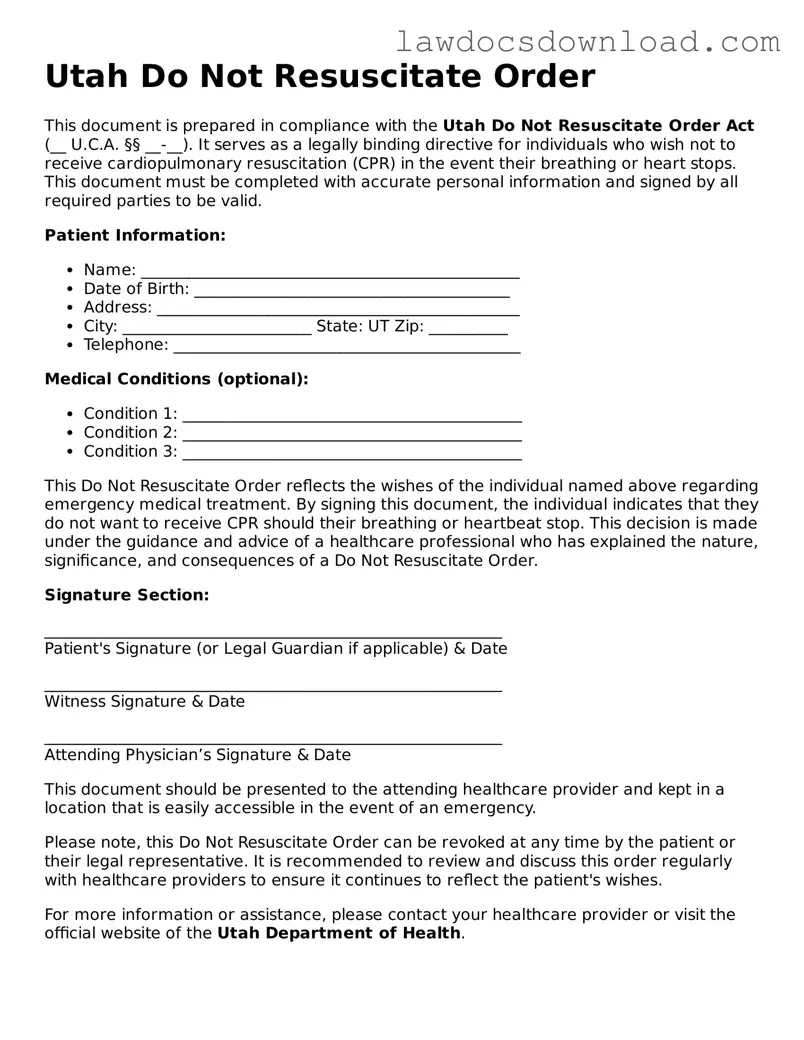The Utah Do Not Resuscitate (DNR) Order form is akin to a Living Will, mainly in its function of expressing medical treatment preferences. Like a Living Will, a DNR gives patients control over their medical care by stating in advance their wishes regarding lifesaving measures, specifically outlining that they do not wish to have CPR or other resuscitative efforts if their breathing stops or if their heart stops beating. Both documents serve as preemptive declarations, meant to guide healthcare providers on how to proceed with treatment during critical moments when patients cannot communicate their wishes themselves.
Similarly, a Medical Power of Attorney (Healthcare Proxy) is closely associated with the Utah DNR Order, as both documents deal with medical decisions when a patient is incapacitated. However, while a DNR specifically addresses the refusal of CPR and similar treatments, a Medical Power of Attorney designates another person to make a broad range of healthcare decisions on the patient's behalf. It allows the appointed agent the authority to make decisions that align with the patient's preferences and values, including but not limited to decisions about life-sustaining treatment.
An Advance Healthcare Directive combines features of the previous two documents, acting as a comprehensive guide for medical care when a person is unable to express their wishes. It usually includes aspects of a Living Will and can designate a healthcare proxy as well. This makes it similar to the Utah DNR Order in its purpose to ensure that a patient’s medical treatment preferences are known and respected, particularly concerning end-of-life care and decisions about accepting or refusing medical interventions, including CPR.
An Out-of-Hospital Do Not Resuscitate order is a document specifically designed for scenarios occurring outside of a hospital setting, such as at home or in a hospice. It closely resembles the Utah DNR Order in its objective and scope. Both documents instruct emergency medical personnel and other healthcare providers not to perform CPR or advanced cardiac life support if the patient's breathing or heart stops. However, an Out-of-Hospital DNR is particularly aimed at instances where medical professionals might be called to a non-hospital location.
A Physician Orders for Life-Sustaining Treatment (POLST) form goes a step further than a DNR by providing detailed instructions for a range of life-sustaining treatments, in addition to CPR. Like the Utah DNR, the POLST is designed for seriously ill or frail individuals for whom health care providers need clear directions on the patient's preferences for treatments such as intubation, mechanical ventilation, and other life-prolonging measures. Both are legally binding and communicate patient wishes directly to healthcare professionals.
The Five Wishes document is a type of advance directive that covers personal, spiritual, medical, and legal wishes at the end of life. Like the Utah DNR Order, it aims to guide healthcare providers and loved ones in decision-making by clearly outlining the patient's preferences concerning their care and treatment, including their desires regarding life-sustaining treatment. Five Wishes offers a comprehensive approach by addressing aspects of one's condition and care that go beyond medical interventions to include comfort and dignity.
A Non-Hospital DNR is similar to the Utah DNR in that it informs medical personnel not to perform CPR, but it specifically applies to individuals receiving care in environments like personal homes or nursing facilities as opposed to hospital settings. Both documents are critical in emergency scenarios where decisions about life-sustaining measures need to be made swiftly and in accordance with the person’s wishes. They provide clear, legally binding instructions for healthcare providers to follow, ensuring that the individual's preferences are honored.
Emergency Medical Services (EMS) Protocols are operational guidelines for emergency medical personnel, including directives on how to approach situations involving DNR orders. Though not patient-specific, these protocols are in line with the purpose behind the Utah DNR Order. They ensure that emergency responders understand and respect the legal documents like DNR orders, which dictate not to initiate CPR or other resuscitative efforts. This engagement between legal documents and emergency response procedures underscores the importance of alignment in medical and ethical considerations during emergencies.
A Health Care Declaration, similar to a Living Will, is a document that specifies a person's wishes regarding healthcare, especially end-of-life care. It shares the objective with the Utah DNR Order of guiding medical treatment based on predetermined patient choices. These documents ensure that an individual's healthcare preferences are respected, particularly concerning the use of life-sustaining treatments and other major medical interventions. By clearly articulating desires for medical care, both help in avoiding unnecessary or undesired treatments in critical situations.
